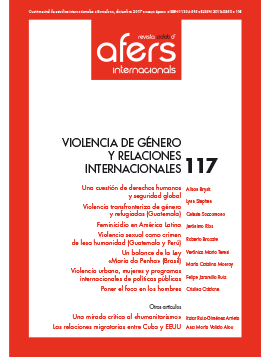Feminicide in Latin America: legal vacuum or deficit in the rule of law?
Keywords:
Latin America, feminicide, impunity, legislation, rule of law, typificationAbstract
Revista CIDOB d’Afers Internacionals, nº 117
Quadrimestral (October-December 2017)
ISSN:1133-6595 | E-ISSN:2013-035X
DOI: https://doi.org/10.24241/rcai.2017.117.3.51
The escalating number of violent female homicides committed by men over the last two decades has compelled many Latin American countries to classify (typify) the crime of gender-based homicide as “feminicide” (or “femicide”). Their objective was to raise awareness and thereby decrease the number of feminicides committed per year. However, although the rate of feminicide fell in many countries, it rose again in subsequent years. In this study, a dataset was built on the rate of feminicide between 2000 and 2014, and an analysis is made of influencing factors. The criminalisation (typification) of feminicide is not found to be significant to predict the rate of feminicide. Instead, low levels of the rule of law and a lack of female representation in decision-making bodies such as national parliaments are found to be the most significant factors in explaining the variation in feminicide trends.
>> The full text articles of this issue are available only in Spanish language
References
Agrast, Mark D.; Botero, Juan C. y Ponce, Alejandro. The world justice project: rule of law index 2010. Washington, D.C.: The World Justice Project, 2010 (en línea) [Fecha de consulta: 19.07.2015] http://worldjusticeproject.org/sites/default/files/WJP_Rule_of_Law_Index_2010_Report.pdf
Agrast, Mark D.; Botero, Juan C. y Ponce, Alejandro. The world justice project: rule of law index 2011. Washington, D.C.: The World Justice Project, 2011 (en línea) [Fecha de consulta: 19.07.2015] https://worldjusticeproject.org/sites/default/files/documents/WJP_Rule_of_Law_Index_2011_Report.pdf
Agrast, Mark D.; Botero, Juan C.; Martínez, Joel; Ponce, Alejandro y Pratt, Christine S. The world justice project: rule of law index 2012-2013. Washington, D.C.: The World Justice Project, 2013 (en línea) [Fecha de consulta: 19.07.2015] http://worldjusticeproject.org/sites/default/files/WJP_Index_Report_2012.pdf
Agrast, Mark D.; Botero, Juan C. y Ponce, Alejandro. The world justice project: rule of law index 2014. Washington, D.C.: The World Justice Project, 2014 (en línea) [Fecha de consulta: 19.07.2015] http://worldjusticeproject.org/sites/default/files/files/wjp_rule_of_law_index_2014_report.pdf
Alvazzi del Frate, Anna. «When the victim is a woman». En: Global Burden of Armed Violence 2011. Geneva Declaration on Armed Violence and Development, 2011, p. 113-144 (en línea) [Fecha de consulta: 15.03.2015] http://www.genevadeclaration.org/fileadmin/docs/GBAV2/GBAV2011_CH4.pdf
Bloom, Shelah S. Violence against women and girls. A compendium of monitoring and evaluation indicators, 2008. Carolina del Norte: USAID (en línea) [Fecha de consulta: 17.07.2015] http://www.cpc.unc.edu/measure/tools/gender/violence-against-women-and-girls-compendium-of-indicators
Bott, Sarah; Guedes, Alessandra; Goodwin, Mary y Mendoza, Jennifer A. Violence against women in Latin America and the Caribbean: a comparative analysis of population based data from 12 countries. Washington, D.C.: Pan American Health Organization y Centers for Disease Control and Prevention, 2012.
Brysk, Alison y Mehta, Aashish. «When Development Is Not Enough: Structural Change, Conflict and Gendered Insecurity». Global Society, vol. 31, n.º 4 (2017), p. 441-459.
Carcedo, Ana. Feminicidio en Costa Rica 1990-1999. San José, Costa Rica: Organización Panamericana de la Salud, 2000.
Carcedo, Ana (coord.). No olvidamos ni aceptamos: femicidio en Centroamérica 2000-2006. San José, Costa Rica: CEFEMINA, 2010.
Carcedo, Ana. «Entrevista: La impunidad alimenta la comisión de feminicidios». Profamilia, mayo de 2012 (en línea) [Fecha de consulta: 03.08.2015] http://aliciaguevaraenelmundo.blogspot.mx/2012/05/ana-carcedo-la-impunidad-alimenta-la.html?q=carcedo
Castro, Roberto y Riquer, Florinda. «La investigación sobre violencia contra las mujeres en América Latina: entre el empirismo ciego y la teoría sin datos». Cadernos de Saúde Pública, vol. 19, n.º 1 (2003), p. 135-146.
CEDAW-Committee on the Elimination of Discrimination against Women. CEDAW General Recommendation n.º 19: Violence against women. CEDAW (1992) (en línea) [Fecha de consulta: 26.06.2015] http://tbinternet.ohchr.org/Treaties/CEDAW/Shared%20Documents/1_Global/INT_CEDAW_GEC_3731_E.pdf
Galanti, Valeria y Borzacchiello, Emanuela. «IACrtHR’s influence on the convergence of national legislations on women’s rights: legitimation through permeability». International Journal of Social Sciences, vol. ii, n.º 1 (2013), p. 7-27.
García Bueno, Mari Paz. Manual de prevención violencia de género en extranjeras: buenas prácticas. Madrid: Confederación Nacional Mujeres en Igualdad, 2014.
Garita, Ana Isabel. La regulación del delito de femicidio/feminicidio en América Latina y el Caribe. Ciudad de Panamá: Secretariado de la Campaña del Secretario General de las Naciones Unidas ÚNETE para poner fin a la violencia contra las mujeres, 2011.
Gómez Arias, Rubén D. La mortalidad evitable como indicador de desempeño de la política sanitaria Colombia: 1985-2001. Medellín: Revista Facultad Nacional de Salud Pública, Universidad de Antioquia, 2008.
Heise, Lori L.; Pitanguy, Jacqueline y Germain, Adrienne. «Violence against women: the hidden health burden». World Bank Discussion Papers, n.º 255 (1994), p. 1-86.
Heise, Lori L. «Violence against women: an integrated, ecological framework». Violence Against Women, vol. 4, n.º 3, (1998), p. 262-290.
Johnson, Janet Buttolph y Reynolds, H. T. Political science research methods. Washington, D.C.: CQ Press, 2012.
Krug, Etienne G.; Dahlberg, Linda L.; Mercy, James A.; Zwi, Anthony B. y Lozano, Rafael. World report on violence and health. Ginebra: World Health Organization, 2002.
Lagarde, Marcela. «Del femicidio al feminicidio». Desde el Jardín de Freud. Revista de Psicoanáisis, n.º 6 (2006), p. 216-225.
Lagarde, Marcela. «Antropología, feminismo y política: violencia feminicida y derechos humanos de las mujeres». En: Bullen, Margaret y Díez, María Carmen (coords.). Retos teóricos y nuevas prácticas. xi Congreso de Antropología. San Sebastián: Ankulegi, 2008, p. 209-239.
Monárrez, Julia Estela. Trama de una injusticia: feminicidio sexual sistémico en Ciudad Juárez. Tijuana: El Colegio de la Frontera Norte y M.A. Porrúa, 2009.
Mujica, Jaris y Tuesta, Diego. «Problemas de construcción de indicadores criminológicos y situación comparada del feminicidio en el Perú». Anthropologica, vol. 30, n.º 30 (2012), p. 169-194 (en línea) [Fecha de consulta: 15.06.2015] http://dev.scielo.org.pe/scielo.php?script=sci_arttext&pid=S0254-2122012000100009&lng=pt&nrm=iso
OACNUDH-Oficina Regional para América Central del Alto Comisionado de las Naciones Unidas para los Derechos Humanos y ONU Mujeres. Modelo de protocolo latinoamericano de investigación de las muertes violentas de mujeres por razones de género (femicidios /feminicidios). Panamá: Campaña del Secretario General de las Naciones Unidas ÚNETE para poner fin a la violencia contra las mujeres, 2014 (en línea) [Fecha de consulta: 12.05.2015]: http://www.ohchr.org/Documents/Issues/Women/WRGS/ProtocoloLatinoamericanoDeInvestigacion.pdf
OEA-Organization of American States. Convencion Interamericana para prevenir, sancionar y erradicar la violencia contra la mujer “Convencion de Belém do Para”. OEA, (9 de junio de 1994) (en línea) [Fecha de consulta: 19.05.2015] http://www.oas.org/juridico/spanish/tratados/a-61.html
OHCHR-Office of the United Nations High Commissioner for Human Rights. «Updated set of principles for the protection and promotion of human rights through action to combat impunity». OHCHR (8 de febrero de 2005) (en línea) [Fecha de consulta: 20.06.2015] http://www.derechos.org/nizkor/impu/principles.html
OHCHR-Office of the United Nations High Commissioner for Human Rights. «Report of the Special Rapporteur on violence against women, its causes and consequences, Rashida Manjoo». UN, A/HRC/20/16/Add.4 (16 de mayo de 2012a) (en línea) [Fecha de consulta: 31.03.2015] http://www.ohchr.org/Documents/HRBodies/HRCouncil/RegularSession/Session20/A-HRC-20-16-Add4_en.pdf
OHCHR-Office of the United Nations High Commissioner for Human Rights. «Report of the Special Rapporteur on violence against women, its causes and consequences, Rashida Manjoo». UN, A/HRC/20/16 (23 de mayo de 2012b) (en línea) [Fecha de consulta: 14.04.2015] http://www.ohchr.org/Documents/Issues/Women/A.HRC.20.16_En.pdf
OHCHR-Office of the United Nations High Commissioner for Human Rights. «Ending impunity for femicide across Latin America». OHCHR (24 de agosto de 2014a) (en línea) [Fecha de consulta: 20.08.2015] http://www.ohchr.org/EN/NewsEvents/Pages/EndingImpunityLAC.aspx
OHCHR-Office of the United Nations High Commissioner for Human Rights. «Honduras: UN Human Rights expert calls for urgent action to address impunity for crimes against women and girls». OHCHR (10 de julio de 2014b) (en línea) [Fecha de consulta: 17.07.2015] http://www.ohchr.org/EN/NewsEvents/Pages/DisplayNews.aspx? sID=14847&LangID=E#sthash.6a3OQytC.dpuf
Prieto-Carrón, Marina; Thomson, Marilyn y Macdonald, Mandy. «No more killings! Women respond to femicides in Central America». Gender & Development, vol. 15, n.º 1 (2007), p. 25-40.
Russell, Diana E. H. «Femicide: Politicizing the killing of females», en: VV.AA. Strengthening understanding of femicide. Washington, D.C.: PATH, MRC y WHO, 2008, p. 26-31 (en línea) [Fecha de consulta: 16.06.2015] https://www.path.org/publications/files/GVR_femicide_rpt.pdf
Russell, Diana E. H. y Radford, Jill. Femicide, the politics of woman killing, Buckingham: Open University Press, 1992.
Stöckl, Heidi; Devries, Karen; Rotstein, Alexandra; Abrahams, Naeemah; Campbell, Jacquelyn; Watts, Charlotte y Garcia Moreno, Claudia. «The global prevalence of intimate partner homicide: a systematic review». The Lancet, vol. 382, n.º 9895 (2013), p. 859-865.
Sullivan, Donna. «Women’s Human Rights and the 1993 World Conference on Human Rights». American Journal of International Law, vol. 88, n.º 1 (1994) p. 152-167.
Swamy, Anand; Knack, Stephen; Lee, Young y Azfar, Omar. «Gender and corruption». Journal of development economics, vol. 64, n.º 1 (2001), p. 25-55.
Toledo Vásquez, Patsilí. «¿Tipificar el femicidio?». Anuario de Derechos Humanos 2008, n.º 4 (2008), p. 213-219.
Toledo Vásquez, Patsilí. Feminicidio. México: Oficina en México del Alto Comisionado de las Naciones Unidas para los Derechos Humanos, 2009.
Tuesta, Diego y Mujica, Jaris. «Femicide Penal Response in the Americas: Indi-cators and the Misuses of Crime Statistics, evidence from Peru». International Journal of Criminology and Sociological Theory, vol. 7, n.º 1 (2014), p.1-21.
UN General Assembly. «Declaration on the elimination of violence against women». UN, A/RES/48/104 (20 de diciembre de 1993) (en línea) [Fecha de consulta: 01.09.2015] http://www.un.org/documents/ga/res/48/a48r104.htm
UN General Assembly. Rome Statute of the International Criminal Court (last amended 2010). UN General Assembly (17 de julio de 1998) (en línea) [Fecha de consulta: 04.09.2015] http://www.refworld.org/docid/3ae6b3a84.html
UN Women. «Causes, protective and risk factors». UN Women (2012) (en línea) [Fecha de consulta: 04.09.2015] http://www.endvawnow.org/en/articles/300-causes-protective-and-risk-factors-.html?next=301
UN Women. Ending Violence Against Women and Girls: Programming Essentials. UN Women (2013) (en línea) [Fecha de consulta: 02.09.2015 http://www.endvawnow.org/uploads/modules/pdf/1372349234.pdf
UNCSW-UN Commission on the Status of Women. «Report on the fiftyseventh session». UN Economics and Social Council, suplemento n.º 7 (4 al 15 de marzo de 2013) (en línea) [Fecha de consulta: 17.08.2015] http://mwia.net/wp-content/uploads/2013/07/official_report_57th_CSW.pdf
Urbano, Clara. «Cifras de feminicidio ii parte». Feminicidio.net (23 de diciembre de 2010) (en línea) [Fecha de consulta: 24.06.2015] http://www.feminicidio.net/articulo/cifras-de-feminicidio-ii-parte#sthash.kboT3gSA.dpuf
Vera, Rafael F. «Feminicidio, un problema global». Jurídicas Cuc, vol. 8, n.º 1 (2012), p. 35-56.
World Bank. Rule of law. The World Bank Group (s. f.) (en línea) [Fecha de consulta: 16.06.2015] http://info.worldbank.org/governance/wgi/#home
World Bank. Control of corruption. The World Bank Group (s. f.) (en línea) [Fecha de consulta: 16.06.2015] http://info.worldbank.org/governance/wgi/#home
WHO-World Health Organization. Understanding and addressing violence against women: femicide. Ginebra: World Health Organization, 2012.
WHO-World Health Organization. Global and regional estimates of violence against women: prevalence and health effects of intimate partner violence and non-partner sexual violence. Ginebra: World Health Organization, 2013.












